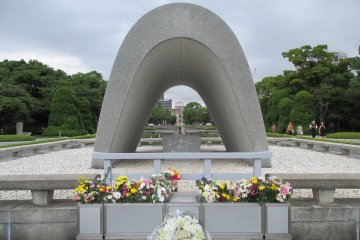
Guide to the Peace Memorial Park
Michelle MontanoPeace Memorial Park stands as a testament to the victims of the first atomic bomb in history and as a vow to protect and forge peace.

Hiroshima Peace Park (平和記念公園) is a large green space in the center of Hiroshima — once the thriving political and commercial heart of the city. On August 6th 1945, the world’s first atomic bomb was dropped over the center of Hiroshima City which suffered widespread damage and suffering. Four years later, this area of the city was designated as a memorial zone.
Today, the Hiroshima Peace Memorial Park, designed by Japanese architect Kenzo Tange, encompasses 30 acres and is home to numerous memorial statues, monuments and a world-class museum. Arguably the highlight of the park is the Peace Memorial Museum, which underwent a major renovation between 2017—2019. The museum focuses on the events of August 6th, with personal images and paraphernalia from the aftermath of the bomb—including a pocket watch that stopped at 8:15am, the time of the detonation.
At the north end of the park, the Atomic Bomb Dome (Gembaku Dome) is a skeletal reminder of the horror of that historic day. At 8:15am, the bomb detonated in the air directly over this area (the exact hypocenter a few blocks away), incinerating much of the city in its path but sparing this building’s metal framework, which remained intact. Today, the A-Bomb Dome serves as a visceral reminder of that fateful day.
Peace Memorial Park is a place of remembrance, perseverance and hope for a peaceful tomorrow.
President Obama made a historic visit to Hiroshima's Peace Park in 2016.
The Children's Peace Monument was built to commemorate Sadako Sasaki and the thousands of child victims from the atomic bombing of Hiroshima. Sadako Sasaki was a young girl who was exposed to radiation from the atomic bomb blast, dying ten years later after a long battle with leukemia. Before she passed away, Sadako had a vision to create one thousand cranes—which she achieved—echoing the Japanese tradition that granted one wish upon doing so. Sadako's wish was for a world without nuclear weapons, and the paper cranes seen here serve as a reminder of this.
The Memorial Cenotaph is otherwise officially known as the 'Memorial Monument for Hiroshima, City of Peace'. Designed by Pritzker Prize winning architect, Kenzo Tange, the cenotaph's shape resembles an ancient clay house that helps shelter the souls of the victims from rain. The stone base houses a registry of the names of over 300,000 people who lost their lives during and after the bombing.
The Peace Bell was created with the hope to abolish nuclear weapons and achieve world peace. Created by bell-caster Masahiko Katori (considered a living National Treasure), the bell is embossed with a singular, unified world map without borders — symbolising an interconnected globe at peace. The surrounding pond contains lotus flowers that come to bloom around early August. Visitors are encouraged to ring the bell as they pray for world peace.
First lit in 1964 in hope of a world without nuclear weapons, the flame continues to burn until they are abolished around the world. The pedestal that cradles the flame evokes the image of two hands joined at the base, palms facing the sky.
Erected in 1977, this statue depicts a child in its mother's arms who blows a trumpet of peace. A crescent moon completes the sculpture.
Completed in 1955, this memorial mound mourns the ashes of the deceased that are unclaimed — either because their names were unknown or their families/relatives died. The vault lies beneath containing the ashes of some 70,000 victims.
Made of 3 iron pillars and supporting a spherical clock, this 20m-tower was completed in 1967. With its daily chime at 8:15am serving as an apt reminder, the clock calls out for world peace and represents a crossroad for humanity.
A monument dedicated to the Korean victims of the atomic bombing. To make up for a shortage of laborers during the war years, Japan had forcibly imported a number of Koreans to work in factories and camps. Several thousand Koreans were in Hiroshima on the morning the atomic bomb was dropped.
Beside the Motoyasu Bridge on the central-eastern edge of the park, the Rest House serves as a Tourist Information Center, as well as gift shop and rest space. Tours are given of the basement, which has been preserved since the time of the bombing and where it is said the only person in the building who was to survive the events of August 6th 1945.
Take the street car (tram) #2 bound for Hiroden-Miyajima or #6 bound for Eba from JR Hiroshima Station. Alight at "Genbaku dome-mae" station.

Peace Memorial Park stands as a testament to the victims of the first atomic bomb in history and as a vow to protect and forge peace.
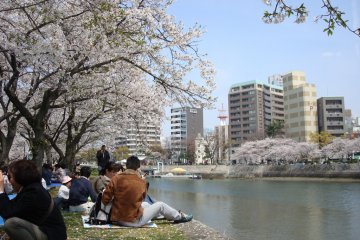
Even if you are in Japan or planning to visit during the season, perhaps you've never considered Hiroshima as a cherry blossom destination.

Peace Memorial Park of Hiroshima looks more impressive with night lighting.

A time to respect those who lost their lives and hope for a peaceful, war-free future for the world. August 6th is a significant day for anyone in Hiroshima.
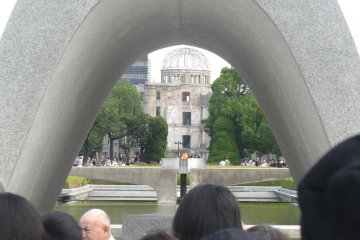
Among the sites in Hiroshima Peace Memorial Park is the Memorial Cenotaph, a large, saddle-shaped concrete structure between the Peace Memorial Museum and the A-Bomb Dome

Thousands of colorful paper cranes adorn The Children's Peace Monument in Hiroshima's Peace Park, many of which have been brought here by children from all around Japan.

The Atomic Bomb Dome, or Gembaku Dome, was once the Hiroshima Prefectural Industrial Promotion Hall. On August 6th, 1945, the world’s first atomic bomb exploded in the air directly over the b...

Hiroshima Peace Memorial Museum, located in southern Hiroshima, sits across from the Atomic Bomb Dome in the Peace Memorial Park. The museum houses information about Hiroshima’s history befor...
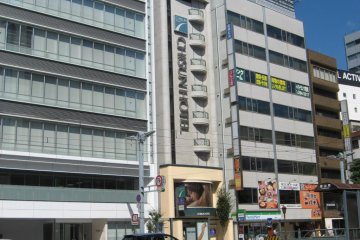
Chisun Hotel Hiroshima, centrally located in the downtown area, is a great place to stay if you're planning a visit to this world famous city.
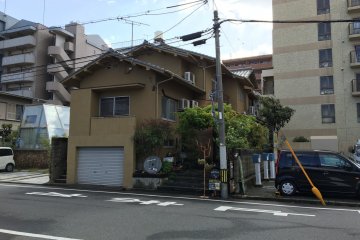
Why Guest House Roku in Hiroshima is a great place for budget travelers looking to make friends
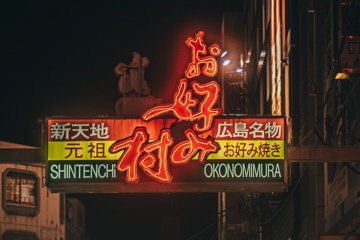
Okonomimura is a Hiroshima-style okonomiyaki theme park located in Shintenchi, Naka-ku, Hiroshima, near the east end of the Hondori shopping street. It has 24 okonomiyaki restaurants, each with a slightly different style and one different selection of ingredients. Okonomiyaki began in the pre-war period as a dish called "Issen Yoshoku" ("" Western food for a dime ""), which was very popular with common people. It consisted of a flour paste cooked with onions, dried shrimp, and spices. After the war, other ingredients such as cabbage, eggs, seafood, buckwheat and wheat noodles were used to improve the diet in these tough times. This is how today's Hiroshima-style okonomiyaki came about. [Photo: Victor Lee / CC BY-NC-ND 2.0]
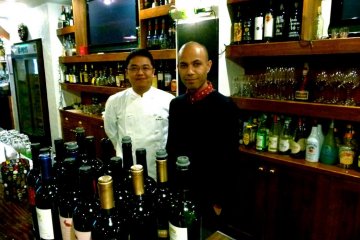
Live-music venue, fun and lively bar on weekends and serves good quality Italian and American style foods.

A spacious Hiroshima-style okonomiyaki shop in a great location, next to Peace park. Family-friendly, Vegetarian-friendly and non-smoking during lunch too.

"Carried to Hiroshima from Tinian Island by the Enola Gay, a U.S. Army B-29 bomber, the first atomic bomb used in the history of humankind, exploded approximately 580 meters above this spot. The city below was hit by heat rays of approximately 3,000 to 4,000°C, along with a blast wind and radiation. Most people in the area lost their lives instantly. The time was 8:15 a.m., August 6, 1945." This plaque on a downtown Hiroshima sidestreet marks the hypocenter of the Hiroshima atomic bombing, with the detonation of 'Little Boy' taking place 600 ft above this spot. Expect to see flowers or paper cranes left in memory at various times of the year.
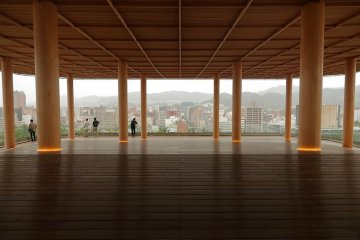
With its beautiful skylines and active waterways, Oizuru Tower offers its visitors a way to see all of that activity—day or night—unobstructed by glass or rails. The wooden floors and ceilings give off a gentle warmth and the pillars that support the ceilings also provide beams of light. Instead of glass or railings, guests can feel the Hiroshima air wash over them thanks to the stainless-steel net fence. With unobstructed views of Hiroshima, including the Peace Memorial Park and the Atomic Bomb Dome (and even Mount Misen of Miyajima on clear days), the tower offers viewers a way to feel at one with the city. Hiroshima Oizuru Tower is also home to an assortment of shops and cafés. Visit the first floor to find that special souvenir of one of Hiroshima’s local products at Hito to Ki. You’ll also find Hiroshima-style okonomiyaki in Akushu Café—including unique wrap-style okonomiyaki. On the 12th floor, you can also fold your own origami crane and leave it on the Oizuru Wall with your well wishes for the future. From the 12th floor to the 1st floor, there is a slide “cool-cool-cool” that runs alongside the spiral staircase. Why not try sliding your way down twelve floors—or just a couple, as you can exit in between floors. While you take a walk inside, browse the original comic created by Shuho Sato—manga artist of “Umizaru” and “Say Hello to Black Jack”—the works inside Oizuru Tower reflect on the theme of peace. No matter what you decide to do, you’ll be delighted by the spaces and experiences that you can create. Discover the past, present, and future of Hiroshima while you gaze out at this bustling city.

Hondori (本通) is one of the main shopping districts in Hiroshima's bustling downtown area. This pedestrian arcade street (shotengai) is a shopper's paradise, lined with everything from clothing stores, trendy boutiques, cafes and restaurants, through to karaoke bars, gaming arcades, purikura parlours and anime shops. When it comes to shopping in Hiroshima, Hondori is a popular choice. As a covered walkway, shoppers can also feel protected from the elements allowing plenty of time to find the perfect souvenir come rain or shine. Hondori is perfectly placed in the heart of Hiroshima's downtown and an easy, worthwhile stop on any Hiroshima itinerary. The street stretches for over half a kilometer from Peace Park in the west (near Sunmall), to the PARCO department store to the east (in the direction of Nagarekawa). It's easy to explore Hondori in combination with other sightseeing spots. For food, try local brands like Andersen's Bakery, the famous Okonomimura just off the eastern side, the well-known The Shack Bar and Grill, (moved from its original Chuodori location) or just keep things simple at the Starbucks on the eastern side — a popular meeting spot for locals, alongside the nearby Alice Garden. When shopping in Hiroshima, you can come across some interesting local chains, like Fresta, Wants and Edion (formerly DeoDeo)—not to mention some interesting heritage. Hiroshima is not just the home for Mazda, but also where it began for another global brand: Uniqlo. Just a few blocks away from Hondori towards Fukuromachi you can stumble across the building where the original branch for 'Unique Clothing Warehouse' (as it was originally known) started back in 1984. It's now occupied by a different business (Chacott), but easy to find being right next door to Hiroshima's branch of Paul Smith. Hondori is reliably busy at all times of the day, with many shops and cafes open until late. For a rainy day excursion, you can continue your shopping journey underground too — the entrance to the Kamiyacho Shareo underground mall can be located at the Hondori Streetcar stop.